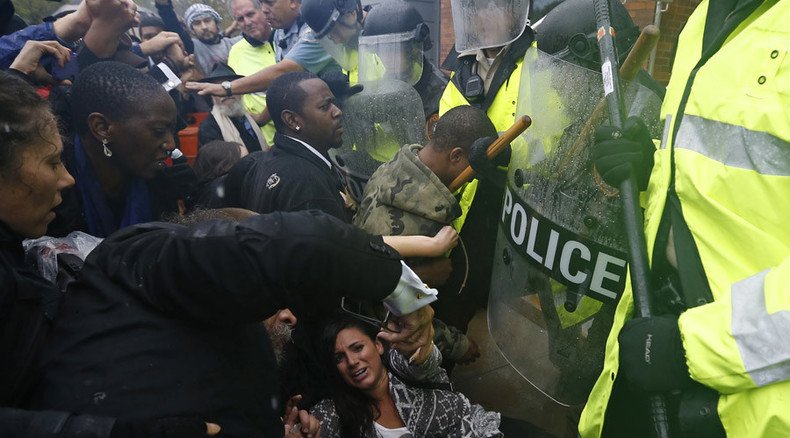DOJ report details mistakes made by Ferguson police following Michael Brown shooting

The improper use of snipers, poor communication, and the removal of officer nameplates are among the errors made by Ferguson police in the weeks following the Michael Brown shooting, says a new Justice Department report.
The report focuses on the police response in the 17 days following the fatal shooting of Michael Brown, the unarmed black teenager who was killed by a Ferguson policeman on August 9, 2014. The document, obtained in advance by AP, is due to be publicly released later on Thursday.
The errors are chronologically detailed in the report, beginning when police wrongly assumed crowds would dissipate following the deadly shooting.
#Ferguson business owners still haven’t recovered from riots one year on http://t.co/CM505demSspic.twitter.com/K1mO8Wti89
— RT (@RT_com) August 15, 2015Among the list of mistakes are: the improper use of police dogs, armored vehicles, and snipers to monitor crowds; the decision by some officers to remove their nameplates; arbitrary orders to demonstrators to keep moving after five seconds, and poor communication among agencies that led to confusion about which policy to follow and who was in charge.
The document states that police failed to use social media to distribute correct information that could have clarified confusion and eased concerns.
Police confusion
Officers from several regional law enforcement agencies were interviewed for the report, with many complaining of inconsistent orders from commanders and saying, “there was no plan in place for arresting people” or they were “unclear who they could arrest.”
Members of the community also spoke of their experiences, stressing that poor relationships with the police were present before the Michael Brown shooting, but were made worse by the incident.
New surveillance footage shows Ferguson protester shot by cops had pistol – police http://t.co/MC0NEvhJrzpic.twitter.com/zL7EJ5UtqW
— RT (@RT_com) August 12, 2015Following its assessment of both law enforcement agencies and local citizens, the Justice Department (DOJ) said: “Having effective relations and communications with the community, recognizing that endemic problems were at the base of the demonstrations, and understanding how the character of the mass gatherings was evolving and spreading beyond the initial officer-involved shooting would have all aided in incident management decisions.”
Several law enforcement agencies whose actions were studied said they have learned from the events.
"What our officers encountered during those first 17 days of unrest has forever changed policing," St. Louis city police department spokeswoman Schron Jackson said in a statement.
150 people arrested over 2 days in #Ferguson, state of emergency still in effect http://t.co/niSwQUY5Hnpic.twitter.com/ydqcRuhMRT
— RT (@RT_com) August 12, 2015"We acknowledge such change by the progressive steps our department has taken to build better community relationships."
She said the agency has made multiple changes since last summer, including hiring more minority officers and launching a community engagement division.
Meanwhile, St. Louis County Police Chief Jon Belmar suggested that law enforcement agencies can learn from “our successes and lessons learned.”
Ferguson could be repeated
The department stressed that the Ferguson situation was not unique, stating that tensions between police and minority communities have been escalating in cities nationwide this year.
Though it acknowledged the public sees Ferguson as “a community of division and violence,” it said the same unrest and protests could occur anyplace where “fostering positive police-community relationships and building trust are not a priority.”
#VIRAL: Heavily-armed 'Oath Keepers' patrol #Ferguson, ‘ready to defend US Constitution’ http://t.co/1szaUX60cIhttp://t.co/ZCjFW8wkde
— RT (@RT_com) August 11, 2015In an introduction to the report, Ronald Davis, director of the DOJ's Community Oriented Policing Services, said the mass protests following the fatal shooting of Brown “represent a new civil rights movement,” aiming to “reform our criminal justice system.”
The review – particularly focusing on the actions of police in Ferguson, St. Louis city and county, and the Missouri Highway Patrol – was conducted following a request from the St. Louis County police chief. The report is not related to a separate DOJ report that criticized Ferguson's police practices and the city's municipal court system in March.
Since the shooting of Michael Brown, a number of other unarmed black men have been shot and killed by police throughout the country, including the highly publicized cases of Freddie Gray and Walter Scott. Demonstrations under the slogan “Black Lives Matter” were launched all over the country following the deaths.












